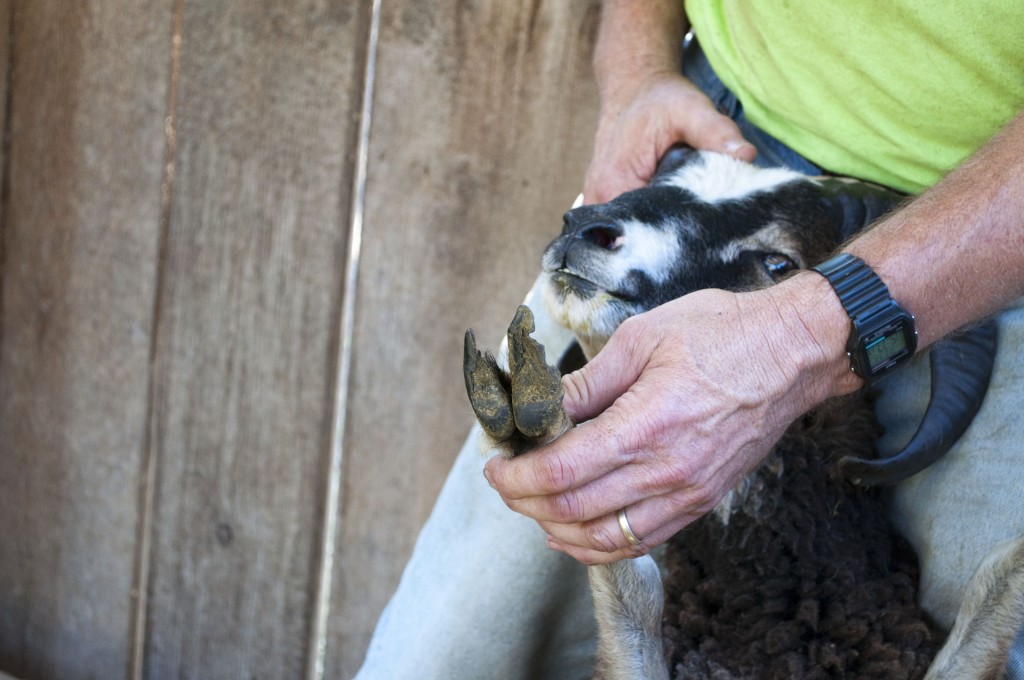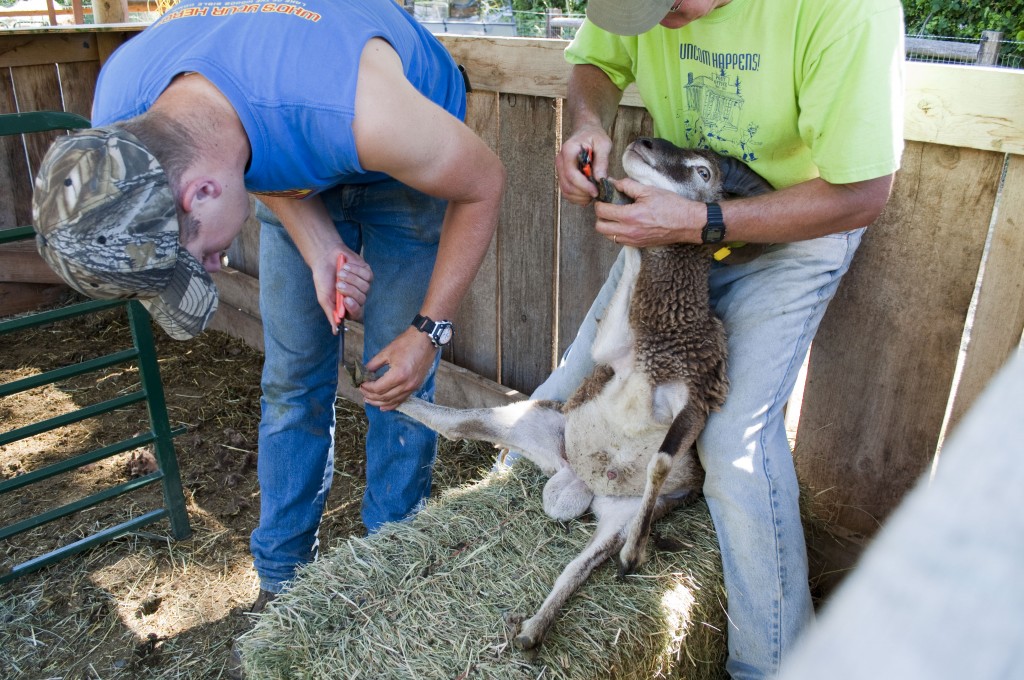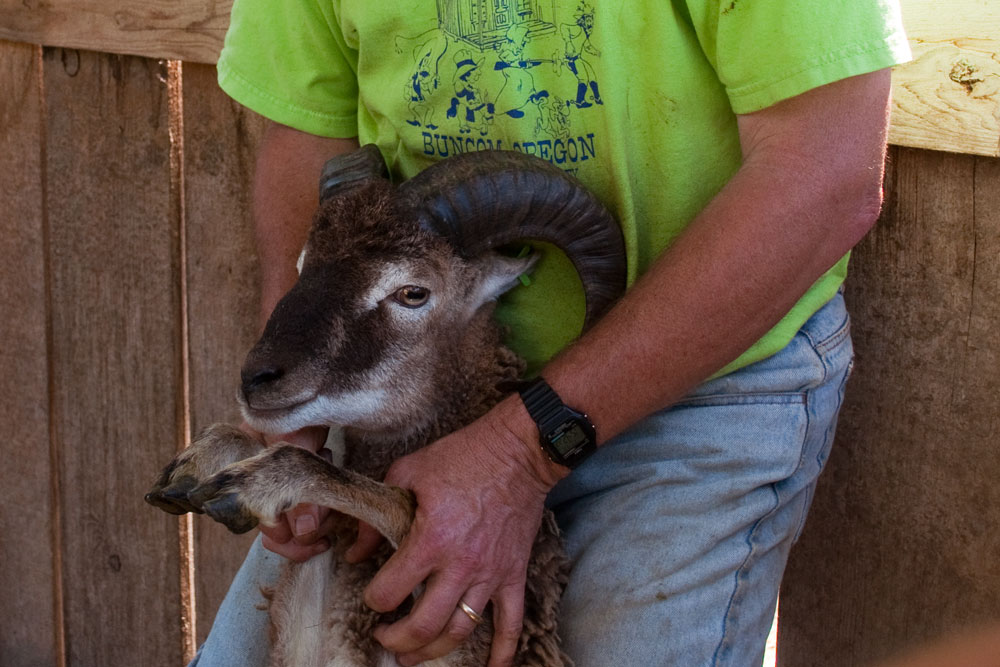Soay sheep hoof trimming revisited
Not much changes from year to year in the lore about hoof trimming for sheep and other cloven-footed animals: use sharp clippers, trim a little at a time so you do not cut through the “quick,” try to create a platform for each hoof so the animal can walk without a hitch in its step. If your Soay are on wet or soft ground all the time, they will need their hooves trimmed at least once, and probably several times, a year. Sheep that must walk over gravel, or even dry sand, during part or all of the year usually do not need a pedicure more than annually.
We trim our flock’s hooves at the time we give them their annual Covexin-8 boosters, also a good time to check for runny stools (a sign of worms), ram horns that may be curling in and need trimming (uncommon, but not a big deal when it happens), and a general look at the animals’ health. You can find a pretty good description of the process in an earlier post on this blog: here.
Earlier this week we were working our rams and I happened to capture a few pictures that address two of the questions we have received since I put up that earlier post.
FAIRY SLIPPERS: LONG HOOF TIPS ON YOUNG SOAY SHEEP
Normally we do not need to trim our lambs’ feet until they are a year old, which means our ram lambs have their first trim at about age 15 months when we conduct our annual Working of the Rams. Although the main “platform” of their hooves stays ground down, they often have long points at the tips of their hooves, what we call “fairy slippers,” as though someone pulled straight out on the ends, creating a turned-up hoof tip that looks like the fairy or jester shoes in movies and cartoons. Here’s a somewhat ratty-looking example:
As you can see, Saltmarsh Tarleton’s fairy slippers had started to wear off and break before trimming day arrived. So far, we have not had any problems with rams tripping over their fairy slippers, and since the main part of their hooves stays relatively flat for the first year, we do not find it necessary to schedule a special mid-year hoof trim for our ram lambs — one less chore during the winter.
RAM DEMEANOR: CAN I REALLY TRIM MY RAMS’ HOOVES WITHOUT GETTING HURT?
Yes, and the more you do it, the easier it becomes. Hoof trimming is neither an art nor a science; it is simply a task that takes practice.
Because we regularly walk among our sheep, including the rams, when it comes time to work the rams they more or less cooperate. The “more” half of the equation is that if your Soay sheep, rams included, are comfortable having you close to them on a regular basis, they will put up much less fuss when you want to get even closer and more personal. The “less” part is that no matter how much time you spend among your sheep, they still do not like to be caught, and they will put up resistance to having their hooves trimmed if you try to conduct the pedicure with the ram standing up and the person with the trimmer kneeling beside the ram. That is asking for a pair of broken glasses or a nice bruise on your face.
We have tried a number of different setups for trimming hooves, including sheep chairs. The sheep chair worked okay for our very large North American rams and it must be wonderful for working the big hulking Suffolks, but it is way to big and unwieldy for our British ewes and rams; they slide down in it, wriggle around, and basically it is useless. Before we had the sheep chair, Steve used to put a bale of hay in the catchpen and put the rams up on their butts, with their backs resting on Steve’s chest. This year, he decided to go back to that tried and true method, and it worked just fine as long as he positioned the bale, the ram, and his own rear end in a way that put the ram’s hooves in position. (It helped a lot that we had Shawn working the rams with Steve, and I highly recommend drafting the nearest strong young person you can find to help with this chore).
The bottom line here (sorry) is to be sure the ram is squarely on his back end. If you do that, he will be calm enough; he will not get away; and he will not be able to land a direct hit at your face. Here is Steve working one of our rams this week:
To give you an idea of the hay bale setup, here’s another picture of Steve trimming the same ram’s hooves, with Shawn working the back legs. If Shawn had not been part of the process, Steve still could have leaned over, with the ram’s head tucked to either side, and grabbed the back legs to work them without undue stress.
This ram, Saltmarsh Royton, was about average in terms of demeanor, not happy at being turned on his butt, but once upended he just sat there while the shepherds did their work.
I probably should have taken movies of this process, but truth to tell, the shepherds engage in quite a lot of colorful talk when they are working the rams, as you can imagine. Once all the bawdy talk is over and the hoof trim (the last step in the annual workup) is finished, Steve generally has a few quiet words with the ram before he turns the ram back into the pasture.
A scratch on the nose and a bit of sing-song chat go a long way towards keeping our rams manageable. And besides, they are sooo handsome!
Side note: If you are curious about Steve’s bilious green t-shirt, it is from our local ghost town, Buncom, the last standing ghost town in Southern Oregon, just three miles down the road from our farm.
For now …




Handsome, indeed! The final steps (the calm time, scratch, and chatting) are undoubtedly the key.